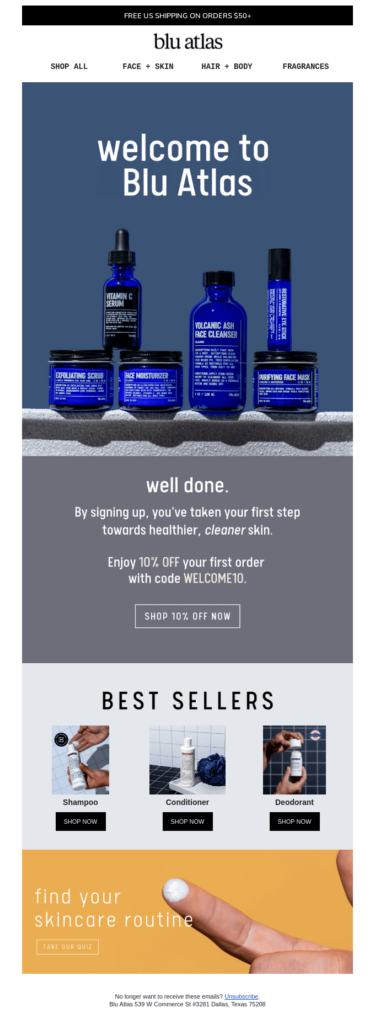Email marketing automation is critical. It is one of the most important tools for engaging and converting leads. Data shows that automation and personalization are now a must-have for every business. This is as opposed to being just a bonus requirement.
To build effective email marketing automation, you’ll need to choose the right campaign type.
Drip and nurture campaigns are both email automation campaign types with slight differences. They are easily mistaken for the same thing. But each has its strengths and weaknesses.
This post compares drip campaign vs nurture campaign in detail so you can learn how and when to use them most effectively to grow your customer base.
What is a drip email campaign?
A drip email campaign is an automated email campaign where you send scheduled email series over a specific period. A drip email campaign aims to educate your audience about your product. It also tells your customers why your product is right for them.
Drip campaigns are a great way to help move your audience down the sales funnel.
Key features
- They’re automated and sent according to a preset schedule
- Includes sending slow and steady email series (from the word “drip”) on a predefined frequency
- They focus on delivering valuable or educational content to keep subscribers interested in the brand.
Drip campaign examples
- Welcome drips: Sending welcome series campaigns helps introduce your products to your audience.
- Engagement emails: These are emails sent to engage audiences at the top of the funnel and stay on top of their minds
- Onboarding campaigns: They provide resources to help customers get started with your product.
- Competitive drips: They emphasize your product’s strengths. They show what sets your brand apart from the competition.
Common use cases
Take a business that sells subscription-based products, for example. The welcome series or onboarding emails could include three to four emails. These would be sent over the next seven days after signup. These could:
- Introduce the brand
- Share the company story and values
- Share product benefits
- Teach customers how to renew subscriptions, etc
Once you’ve landed customers, you can then use reminder drip campaigns. They alert customers when their next refill approaches.

Image via Really Good Emails
Another common use case for drip campaigns would be sharing useful information to keep subscribers engaged.
For example, skincare brands can teach customers about skincare routines and picking the right products. This could be done through a series of short email courses.
Here’s an example from Heyday.

Image via Really Good Emails
Advantages
- Drip emails are great for engaging existing customers
- They help move leads through the sales funnel as they involve sending educational resources to subscribers
- They’re easy to set up and require less analytics compared to nurture campaigns
- Drip campaigns require fewer resources to set up, such as simpler technology and less experience.
What is a nurture email campaign?
Nurture email campaigns are a series of automated emails that are sent based on the lead’s behavior. You’ll need deeper insights. These include your audience’s engagement history, clickmaps, and browsing history. Such specific details are needed to make nurture emails work better.
As a result, these campaigns are more targeted and personalized. So, compared to drip campaigns, they tend to yield better results. These include improved engagement, lower churn rates, and higher conversions.
Email nurturing campaigns are focused on building a strong relationship with customers. These emails help guide prospects through their buying journey.
Key features
- They’re based on a lead’s behavior
- Involves lots of analytics and behavioral data
- Requires lots of resources and technology to set up
Nurture campaign examples
- Cart abandonment emails: These nurture campaigns remind customers to complete their checkout process. They’re triggered when a customer abandons their cart and stops when a customer makes a purchase.
- Win-back campaigns: These are sent to inactive subscribers to reengage them and get repeat business.
- Upsell and cross-sell emails: They suggest related or upgraded products based on customers’ purchases. They are aimed at optimizing revenue and improving customer experience.
- Post-purchase emails: This includes emails such as order confirmations, feedback requests, delivery updates, refill reminders, etc. They provide follow-up information to customers to help enhance their experience.
Common use cases
Nurture campaigns are commonly used for ecommerce. Here’s an example.
Once a subscriber signs up, you could send a targeted welcome email with clear CTAs leading back to the company’s product page. This email could include a welcome coupon or discount code to encourage them to make a purchase.

Image via Really Good Emails
If a prospect purchases training socks, you could send an order confirmation that would double as a thank-you note. Then, suggest a few cross-sells or upsells based on this purchase like training shorts to complete the kit, etc.
Here’s an example.

Image via Really Good Emails
These emails build a personal relationship with customers. They also increase store revenue.
Advantages
- They help guide your leads through their buying process
- You’ll align your content with user needs and ensure better customer experience
- Nurture emails build deeper, more long-lasting relationships with leads
Comparing drip campaign vs nurture campaign
As noted, drip and nurture campaigns serve slightly different roles in your email strategy. Let’s compare the two in detail.
Strategic focus
Drip campaigns focus on keeping in touch with subscribers. As such, they include a sequence of emails designed to educate and build trust with prospects.
This achieves the following marketing goals:
- Provide information to answer your subscribers’ questions
- Share the benefits of your product
- Guide customers through their onboarding process
Nurture campaigns, on the other hand, focus on providing personalized content that caters to customers’ specific needs. Here’s how this aligns with your marketing goals.
- Nurture campaigns are an excellent way to qualify leads. You can segment them and send timely, trigger-based emails that bring you closer to conversion.
- These campaigns also help increase customer loyalty and encourage repeat purchases.
Email content customization
Drip email campaigns have moderate personalization. The segmentation is based on more generic features such as demographics, location, and personal details.
As a result, they allow you to send relevant emails to prospects that keep them engaged and drive conversion.
In contrast, nurture campaigns are highly personalized and in tune with the customer’s needs and preferences. The messaging is more targeted and, therefore, more effective in addressing specific user needs.
This leads to higher engagements, customer trust, and, ultimately, higher conversions.
Engagement and conversion
Engagement levels are different between nurture campaigns vs drip. With drip campaigns, the engagement rates may plateau as subscribers get used to your communication.
To improve engagement and conversion rates with drip emails, you’d need to optimize CTAs, subject lines, email format, timing, etc.
Nurture campaigns inspire higher engagement rates since the content is tailored to each recipient’s interests.
To keep customers engaged with nurture campaigns and to improve conversions, you need to leverage items like dynamic content, advanced segmentation, content relevance, etc.
Implementation challenges
Let’s look at the challenges of nurture vs drip campaigns on marketers. Marketers face the following challenges with drip campaigns:
- Creating content that will remain relevant to the recipient throughout your campaign is challenging.
- Finding the right timing and cadence for sending your drip emails can be challenging
- Drip campaigns have limited personalization, which can make them less effective.
You can optimize your future drip campaigns by monitoring and analyzing your key metrics.
In contrast, nurture campaigns come with challenges such as:
- You need more data, time, and resources to create them
- Dynamic segmentation is harder and requires email marketing experience
- You need to adapt to audience behavioral changes continuously
One way to tackle these challenges is by properly planning your campaign strategy and using robust email automation software, like GetResponse, Klaviyo, or Omnisend.
Goal alignment
Drip campaigns keep prospects engaged with your brand. They’re effective for sending promotional content, product updates, informative content, etc.
However, their personalization is limited. So, they may not be as effective at converting customers and encouraging repeat sales. This is where nurture campaigns shine.
Nurture emails are highly personalized. They are most effective for building lasting customer relationships. This improves the customer’s experience and loyalty to your brand.
Audience Understanding
Nurture campaigns require a deep understanding of your target audience. To be effective, you’ll need to track every interaction your subscribers have with your brand.
This includes their
- Engagements with your emails
- Website activity
- Purchasing behavior
- Customer preferences
Further, you’ll need to know a bit about their personal details. This includes their location and demographics. All this helps you segment your audience to send them relevant campaigns.
This is very crucial to the success of nurture campaigns.
With drip campaigns, you do not require this level of knowledge of your customer. You’ll only need to understand their general interests and know their details for basic personalization.
Resource considerations
Drip campaigns only need a few resources than nurture campaigns. They take less time to send and require less sophisticated automation software. Businesses with limited budgets can use drip emails to gather and nurture leads.
Nurture campaigns require heavy resources in comparison. You’ll need an advanced email marketing tool. It should have strong automation, segmentation, and reporting.
Platform platforms with advanced ecommerce features like marketing automation are often more expensive than basic email tools. However, some of them are still affordable for all kinds of businesses.
Check out our recommendations for ecommerce email marketing platforms.
Best practices for successful campaigns
Building a successful email campaign requires a lot of planning and continuous optimization. Here are some best practices for successful drip and nurture campaigns.
Drip campaigns
- Define your goals. Every drip campaign should aim toward achieving a specific goal. This includes an introduction to the product, new updates, etc. The drip campaign works well for brand awareness.
- Make sure your content adds value. Understand your audience’s needs and interests. Then, you can craft compelling drip campaigns.
- Set a frequency based on factors such as your sales cycle. This way, you’ll keep your audience engaged without overwhelming them.
Nurture campaigns
- Learn your customers’ lifecycle and identify the main stages. Then, tailor your nurture campaigns to each. For instance, creating relevant emails for prospects in the consideration and decision stages.
- Monitor your performance metrics. Nurture campaigns are largely data-driven. Therefore, tracking your performance metrics is critical to identifying areas where you can improve.
- Use many channels to communicate. Besides emails, nurture campaigns work best if you engage prospects on many channels. These include SMS, landing pages, push notifications, and social media.
- Test and iterate. To improve your nurture campaigns, you’ll need to test your content, messages, timing, and more. Do A/B tests to find the best versions of your best campaigns.
Drip campaign vs nurture campaign: Wrap up
Both drip and nurture campaigns fulfill unique roles within your email marketing strategy.
Drip campaigns focus on sending scheduled messages. These messages aim to lead prospects down the sales funnel. They’re excellent for keeping customers engaged with your brand.
Nurture campaigns focus on building long-lasting relationships with prospects. They also guide them through their buying journey. They work better for engaging customers and increasing sales. They also encourage repeat purchases.
Depending on your business needs and budget, you can use one or both campaigns. The key is aligning each strategy with your marketing goals and monitoring and improving performance nonstop.
